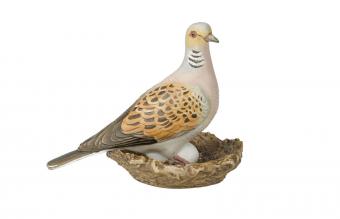
Birds, with their inquisitive movements and elegant maneuvers, have served as inspiration to artists for centuries, and while creatives like John James Audubon are well-known for their takes on these lively creatures, ceramic contributions, such as the Goebel birds of the mid-century, are just as showstopping. Even the most novice ornithologist would get great joy out of owning one of Goebel's incredibly detailed porcelain birds.
The Story Behind the Goebel Porcelain Company
Franz Detleff Goebel partnered with his son, William, to launch the Goebel Porcelain Company in 1871. Based in Germany, the manufacturer created luxury porcelain items that quickly made their way across the European continent and into the American market. Their most popular item wasn't introduced until 1935 when Goebel joined together with Sister Maria Innocentia Hummel to introduce a series of cherubic, cherry-cheeked kids figurines to the world. In 1950, Goebel was granted permission by Walt Disney to manufacture figurines of Bambi and her woodland friends. This marked the start of consumer interest for having more animal figurines, and the company began to manufacture other animals alongside Disney's forest inhabitants. Among these small animal ceramics were the incredibly life-like bird figurines that were initially introduced in the 1960s.
Collecting Goebel Birds
Although these porcelain creatures aren't as famous as the company's Hummel kids are, their lifelike appearance makes them incredibly appealing to both animal lovers and porcelain collectors alike. The number of different breeds you can possibly collect feels endless, ranging from the common robin to the exotic toucan and everything in between. Here are a few tips and tricks to collecting these birds that can help make your 'birding' a breezy affair.

Goebel Birds and Designer Partnerships
Unlike with their Hummel figurines, Goebel collaborated with many different artists to create pieces for their birds porcelain line. This means that you'll likely encounter various designer names and trademarks on the bottoms/bases of each bird you find alongside the typical Goebel backstamps. One of the most significant of these partnerships was between the company and Gunther Granget, an independent porcelain artist. Originally, Granget created birds for Hutschenreuther but transitioned to working for Goebel in 1977. Unfortunately, he left the manufacturer in 1984 to return to Hutschenreuther, but the beauty of his prolific pieces, like the life-size sculpture Silver Wings, make them highly collectible today.

Size and Style Variation Among Goebel Birds
Vintage Goebel bird figurines come in a wide variety of shapes and sizes. Since there were so many different artists contributing to the bird's designs, it is a bit difficult to identify a Goebel bird based on shape or size alone. In terms of size, there are examples of birds that can fit in the palm of your hands (like the greenfinch or wren) and others that span whole tabletops (like the massive fully-plumed peacock). While this may make identifying a Goebel bird in the wild seem rather daunting, there are a few distinctive styles that you might come across in your search which can point you in the right direction to a potential Goebel.
- Baseless Birds - These birds appear seated and their 'base' is actually underneath the bird itself.
- Birds Resting on a Branch - These are smaller sculptures with birds like orioles, chickadees, and parakeets clinging onto a tree's branch for purchase.
- Standing Birds - This style is usually reserved for larger birds and birds breeds (like storks and herons) that naturally spend a lot of time on their legs.
- Large-Scale Birds - Generally, these birds are designed to be showstopping pieces and take up a lot of space, like the peacock does with its large plumage and the eagle does with its outstretched wingspan.
- Bird Lamps - The company produced six different bird lamps, which include breeds like the robin and the woodpecker.

Goebel Bird of the Year Series
Since 1990, Goebel has worked in tandem with the Bavarian Society for Bird Protection to help support environmental conservation and preservation efforts. An important aspect of their joint initiative is Goebel's Bird of the Year ceramics series. Every year, the Bavarian Society for Bird Protection designates one bird whose protection they want to highlight and Goebel's creates a commemorative figurine of that bird. For example, the Turtledove was 2020's Bird of the Year, 2019's was the Skylark, and so on.

Goebel Birds' Values
These lively and brightly glazed porcelain birds' estimated values range from about $20 to $150, depending on the bird's age, how many of them have been produced, and what condition they're in. Generally, most single birds tend to bring in around $40 at auction. For example, this 1967 Goebel nuthatch bird was listed for almost $40 and this small robin was listed for almost $50. Rarer pieces are worth double or triple those prices, like one of the Goebel lamps and a 1968 black throated jay which were both listed for about $100 each. While some of these figurines can cost a nice chunk of change, most birds you find will probably be tagged for less than $50, making them a good beginners option to for starting a ceramics collection.
Adventures Abound With Vintage Goebel Birds
Goebel's vintage birds series may not be their most well-known, but they do have the greatest lasting appeal because of their hyper-realistic designs and glaze/painting techniques, which makes these pieces perfect for those of you who shy away from the typical floral ceramics your grandmothers gravitate towards.







